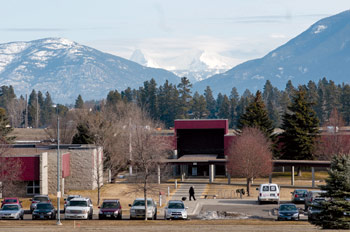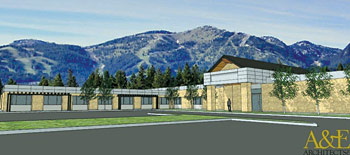The idea of a four-year university program in the Flathead Valley is gaining momentum to the point of acquiring an air of inevitability. And every way local officials look at it – on paper, in theory and presumably in practice – such a plan seems to make more and more sense.
Most notably, the population base is here, with more than 90,000 in Flathead County and well over 100,000 in the greater valley down to Polson. Along with that growing population comes a renewable student base and diversifying economy. As has been repeated time and again, people want to move here. They are attracted to the region’s quality of life, characterized by a marriage between the wild outdoors and sufficient modern infrastructure to support 21st century businesses.
Providing one more incentive to boost the quality of life, particularly a critical cornerstone like a four-year university, appears to be a logical next step in the Flathead’s evolution, ripe with economic and cultural potential.
Those are the dynamics and demographics that education officials have been examining as they explore the possibility of establishing a four-year higher education institution in the region. Flathead Valley Community College’s board of trustees has identified a university center as a top priority.
FVCC, by far the state’s largest community college with an annual enrollment of more than 4,000, already offers bachelor and graduate degrees, though primarily through distance learning. In limited cases, partner universities provide on-campus faculty to teach courses in specific degrees, such as education through the University of Great Falls and nursing through Montana State University.
But the FVCC board and college officials see the need to increase the four-year opportunities on campus. And, quite importantly, so do officials with the Montana University System.
Kevin McRae, associate commissioner of higher education, confirmed that the Montana Office of the Commissioner of Higher Education has been in talks with FVCC officials about expansion. He said his office is “on board.” Considering towns like Butte, Dillon and Havre have universities, it should be no surprise that talks of a four-year school are gaining traction in one of the state’s most densely populated areas.
“It definitely seems that it’s worth our while to try to assess the need for and potential for four-year programs in the Flathead,” McRae said in an interview last week, adding that FVCC is “a thriving, excellent community college that has demonstrated clear potential” to take the next step.
“You have the population base and community infrastructure, and a quality college and board of trustees that could make it work if it’s possible anywhere,” he said.
In March, Flathead Valley Community College will reach out to local businesses to gather input on which baccalaureate degrees should be offered. From that needs assessment, McRae said education officials will have a better idea about curriculum and therefore the appropriate university partnership: either with the University of Montana or Montana State University.
There is no precise timeline, but McRae said following the needs assessment officials could begin developing a university plan to ultimately be approved by FVCC and the state Board of Regents. Faculty and other resources would then have to be put in place. McRae said most likely the expansion would start out with bachelor degrees and perhaps down the road could grow to include graduate degrees.
“A year or two – I think that’s feasible,” McRae said of a possible timeline on opening a university. “There is a process. Certainly it doesn’t seem to me that it would be ready by next fall.”
And earlier this month, developers in Whitefish held a series of community discussions about the possibility of locating a four-year higher education institution at the old North Valley Hospital site. The developers – River Opportunity Project Enterprise – purchased the 12-acre Whitefish hospital property in September. They have hired a consultant, the Education Alliance based in Boston, to conduct a feasibility study for bringing a four-year school to Whitefish.
|
Rendering of proposed college at the old North Valley Hospital site in Whitefish. | Contributed image – Click to Enlarge |
“The potential is enormous,” River Opportunity Project Enterprise said in a press release. “Whitefish offers a destination setting for new undergraduate – and potentially graduate – degrees, which bring huge dividends to the economy and culture of any community.
“The hope and expectation is to design and collaborate with Flathead Valley Community College, Montana State University, The University of Montana and other colleges and universities in the region.”
Donald DuBeau, a partner in the group, said in an interview that about 150 people attended the six town hall meetings and “99.9 percent” of the feedback was positive. He emphasized that plans are in the early exploratory stage and nothing would be done without “a collaborative effort with all the schools in the region,” noting that FVCC “has done a tremendous job.”
McRae said he was familiar with the Whitefish plan only through a newspaper article and hasn’t spoken with the developers.
“We’ve never heard from them, so we don’t know where they are,” he said. “All of our focus on higher education exploration there – 100 percent of our exploration – is through Flathead Valley Community College, through President (Jane) Karas and the board of trustees.”
What FVCC’s efforts and the Whitefish North Valley Hospital proposal share in common is a vision of higher education’s role in the Flathead’s future, rooted in an understanding that a four-year university’s impact extends well beyond the campus.
In places like Coeur d’Alene and Spokane, expanded higher education has injected both dollars and cultural vivacity into the communities, though different in scope and model. Whether the Flathead would follow a similar path remains to be seen, but even if the college’s four-year offerings were relatively small, especially at the onset, economic ripple effects would still be felt, as business officials have noted.
Kalispell Chamber of Commerce President Joe Unterreiner said a four-year university is a top priority for his organization and members. In recent years, the chamber has sent representatives to “peer communities” specifically to look at the role colleges play in the economy. Unterreiner has accumulated various tidbits of insight from visits to places like Bend, Boise and Coeur d’Alene, with an overriding theme that the growth of the colleges has helped spur the growth of the communities in other ways.
A four-year school could help retain students after high school, allowing them to complete bachelor degrees in the valley and training the next generation’s workforce at home. It could also attract students from outside the area, perhaps bringing in new educated members of the workforce or at least, if they leave after school, still bringing in their dollars and community presence while they live here.
“It would be great for the community, economy, families and industry,” Unterreiner said. “We think it would be very important for our economy here.”
Tech companies like Nomad Global Communication Solutions outside of Columbia Falls and ZaneRay Group in Whitefish exemplify the flexible geographical nature of modern entrepreneurism. Working with major clients across the country, they are able to set up shop in a place their founders love to live and play. Flathead business officials frequently talk about the potential of attracting more companies like Nomad and ZaneRay, and they see a university as a valuable incentive.
Clay Binford, Nomad’s vice president of sales and marketing, says he has already seen FVCC’s positive impact on the local economy. Stepping up to a four-year university would only expand the college’s economic role. Nomad builds high-tech emergency command and communication vehicles used for disaster relief and other purposes, operating through contracts with major federal agencies. The firm has 80 employees with high average wages.
“We have a very excellent relationship with FVCC and appreciate the education they’re able to provide for potential employees in the valley,” Binford said. “Having a four-year university would just enhance the potential for those employees here and for being able to draw from local resources.”
 |
|
Flathead Valley Community College (FVCC) – Lido Vizzutti | Flathead Beacon |
Binford said some young people leave the valley to obtain their four-year degrees with the goal of returning after college. But many of them, for a variety of reasons, don’t come back right away or maybe even ever. Keeping them here to begin with would have clear advantages. He could especially see a local university’s role in providing quality training in computer science and communications.
On a broader level, Binford believes a university would simply make the Flathead a better place to live.
“It brings a certain amount of vibrancy to the area when you have that influx of young talent and different ideas and innovations that can percolate to the surface, not only from a cultural standpoint but a business standpoint and what that means for the valley from an economic standpoint,” he said.
Reed Gregerson, president of the Whitefish web design and marketing company ZaneRay Group, says his firm typically doesn’t hire employees straight out of college, meaning he wouldn’t likely be tapping into the local college graduate pool. Even so, he said more four-year opportunities would benefit his business in a number of ways, including interns and further training for employees.
“It would help with advanced education – an engineer could go back to school to learn some business skills and design skills,” Gregerson said as an example. “Having that locally would be great.”
Gregerson echoed Binford in pinpointing computer science as an important field, describing the tech industry as a vital and growing industry. ZaneRay was named one of the 10 best places in the country to work by Outside magazine and boasts a national client list that includes Patagonia.
“Salaries in the tech business are going up, up and up,” he said. “Basically this business never had a recession.”
There are various models to be explored, McRae said. Schools like UM Western in Dillon and MSU-Northern in Havre are full-fledged universities with a variety of four-year degrees and athletic departments that offer scholarships. Then there are two-year schools like Helena College UM and Great Falls College MSU that offer four-year education in coordination with partnering schools, which FVCC does to some degree now.
The March needs assessment will help FVCC and state education officials begin zeroing in on a specific model. From there, it can be determined whether the community college needs new facilities or has sufficient existing space.
From the North Valley Hospital proposal to FVCC’s exploratory plans, Karas said it’s exciting to see the Flathead embracing higher learning and looking toward the future.
“The focus on the importance of education is really a wonderful thing,” Karas said. “People understand the difference not in just an individual’s life but in the whole valley’s success that having an educated community can make.”
